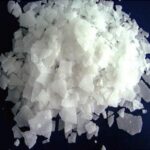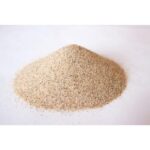Copper Slag
Copper Slag is a by-product generated during the smelting and refining process of copper. It is a granulated material with similar properties to sand, and it has various applications in the construction industry.
Here are some of the common uses of copper slag in construction: 
Concrete production: Copper slag can be used as a partial replacement for fine aggregates (such as sand) in concrete mixtures. It provides several advantages, including improved workability, increased compressive strength, and reduced permeability. The addition of copper slag can enhance the durability and long-term performance of concrete structures.
Road construction: Copper slag can be used as a replacement for natural aggregates in road base and sub-base layers. It can improve the strength and stability of the roadbed while reducing the need for virgin materials. The angular shape and high frictional properties of copper slag make it suitable for use in road construction and pavement applications.
Embankments and landfills: Copper slag can be utilized as a fill material in embankments and landfills. Its high density and stability make it suitable for supporting structures and controlling erosion. It can also provide a cost-effective alternative to traditional fill materials.
Blast cleaning and surface preparation: Copper slag can be used as an abrasive material for blast cleaning and surface preparation of various structures, including bridges, tanks, pipelines, and ship hulls. Its hardness and angular shape make it effective in removing rust, scale, and old coatings from metal surfaces.
Roofing granules: Copper slag can be processed and used as granules for roofing applications. These granules provide an aesthetically pleasing appearance, as well as excellent thermal properties. They can be applied to shingles and other roofing materials to enhance durability and reflectivity.
Insulation material: Copper slag can be processed into lightweight aggregates that can be used as insulation material in construction. These aggregates have low thermal conductivity and high heat resistance, making them suitable for thermal insulation applications.
USES of COPPER SLAG OTHER THAN construction
Apart from construction, copper slag has several other uses in various industries. Here are some additional applications of copper slag:
Abrasive blasting: Copper slag is commonly used as an abrasive blasting material for cleaning and surface preparation in industries such as shipbuilding, steel fabrication, and metalworking. Its hardness and angular shape make it effective in removing rust, scale, and coatings from surfaces.
Water and wastewater treatment: Copper slag can be used in water and wastewater treatment processes. It has ion-exchange properties and can be employed as a filter media for the removal of heavy metals and other contaminants from water. Additionally, copper slag can also be used as an adsorbent for the removal of organic pollutants.
Soil remediation: Copper slag can be utilized for soil remediation purposes. It has the ability to stabilize heavy metals in contaminated soils, preventing their migration into groundwater. Copper slag can be mixed with the contaminated soil to immobilize and reduce the bioavailability of heavy metals.
Abrasive in manufacturing processes: Copper slag can be used as an abrasive material in various manufacturing processes, such as cutting, grinding, and polishing. It is particularly useful for applications where a high degree of surface roughness or precision is required, such as in the production of precision components and electronic devices.
Roofing and road surfacing: Copper slag can be processed into granules or particles for use in roofing materials, such as asphalt shingles. It provides excellent thermal properties and can help reduce heat absorption in buildings. Additionally, copper slag can be used as an aggregate in the production of asphalt mixtures for road surfacing.
Manufacturing of copper-based products: Copper slag contains residual copper that can be recovered and used for the production of various copper-based products. Through appropriate processing techniques, copper slag can be recycled to extract copper, which can then be used in the manufacturing of electrical wires, plumbing fixtures, and other copper-based products.
It’s important to note that the specific application and use of copper slag may vary depending on local regulations, availability, and project requirements. Proper testing and evaluation should be conducted to ensure the suitability and performance of copper slag in specific construction applications.
It’s worth mentioning that while copper slag has these additional uses, the specific applications and feasibility may vary depending on factors such as local regulations, industry requirements, and the availability of copper slag.
Copper Slag is a byproduct of the copper extraction process and has several potential uses and applications in construction due to its physical and chemical properties.
Here are some of the common uses and applications of copper slag in the construction industry:
Sandblasting Abrasive: Copper slag is often used as an abrasive material in sandblasting processes. Its sharp-edged particles make it effective for cleaning and preparing surfaces, such as metal, concrete, and stone, before painting or coating.
Concrete Production: Copper slag can be used as a partial replacement for sand in concrete mixtures. It improves the workability of concrete and enhances its durability and strength. When used in concrete, it can reduce the consumption of natural resources and decrease the environmental impact.
Asphalt Mixtures: Copper slag can also be added to asphalt mixtures to improve their performance. It can enhance the skid resistance of road surfaces and reduce the overall cost of asphalt production.
Construction Fill: In some cases, copper slag can be used as a construction fill material for embankments, road bases, and backfilling. Its high density and angular shape provide stability and support.
Abrasive Blasting Grit: In addition to sandblasting, copper slag can be used as a grit for various abrasive blasting applications, such as cleaning and preparing steel surfaces for welding or coating.
Manufacture of Roofing Tiles and Bricks: Copper slag can be incorporated into the production of roofing tiles and bricks, providing a cost-effective alternative to traditional materials. These products can be more durable and offer better thermal insulation properties.
Landscaping and Decorative Uses: Copper slag can be used in landscaping and decorative applications, such as in the creation of pathways, garden beds, and decorative concrete finishes. Its attractive reddish-brown color can enhance the visual appeal of outdoor spaces.
Erosion Control: Due to its stability and ability to interlock, copper slag can be used in erosion control applications, such as retaining walls and slope stabilization.
Pipe Bedding Material: Copper slag can be used as a bedding material for pipes, providing support and preventing pipe movement within trenches.
Water Filtration: In some water treatment applications, copper slag can be used as a filter medium for the removal of impurities and contaminants from water.
It’s important to note that while copper slag has various potential applications in construction, its suitability for a specific project should be determined based on its physical characteristics, local regulations, and environmental considerations. Proper testing and assessment should be carried out to ensure its safe and effective use in construction projects. Additionally, the use of copper slag should be in compliance with environmental and safety standards to prevent any adverse effects on the environment and human health.
Copper Slag has a range of uses and applications beyond construction.
Here are some other application areas where copper slag can be utilized:
Shipbuilding and Repair: Copper slag is often used for cleaning and surface preparation of ship hulls and other maritime equipment. Its abrasive nature helps remove rust, coatings, and marine growth effectively.
Rust and Corrosion Removal: Copper slag is employed in industries where rust and corrosion need to be removed from metal surfaces, such as bridges, tanks, and pipelines.
Manufacturing of Abrasive Products: Copper slag can be processed and used as a raw material in the production of various abrasive products like grinding wheels, abrasive papers, and abrasive blasting media.
Manufacturing of Refractory Materials: It can be used as an additive in the production of refractory materials like bricks and castables for furnaces and kilns due to its high melting point and resistance to heat.
Ship Ballast: In some cases, copper slag has been used as ballast in ships to provide weight and stability.
Slurry Abrasion Testing: Copper slag is employed in laboratory settings to simulate abrasive wear and evaluate the performance of materials and coatings in abrasive environments.
Water Jet Cutting: Copper slag can be utilized as an abrasive material in water jet cutting, which is a precise cutting method used in industries such as manufacturing and metal fabrication.
Concrete Block Manufacturing: Some manufacturers use copper slag in the production of concrete blocks and pavers as a substitute for sand, improving the strength and durability of these products.
Fertilizer Additive: In agriculture, copper slag can be processed to remove impurities and used as a component in fertilizer formulations, providing essential trace elements to plants.
Artificial Sports Surfaces: Copper slag has been used in the creation of artificial sports surfaces, such as tennis courts and running tracks, due to its durability and impact resistance.
Sound Insulation: Copper slag can be employed in sound-absorbing materials and products due to its dense and porous nature, making it useful in noise reduction applications.
Manufacturing of Copper Sulfate: Copper slag can be processed to extract copper sulfate, which is used in agriculture as a fungicide and in various industrial processes.
It’s important to note that the suitability of copper slag for these applications can vary depending on factors such as its physical properties, impurities, and local regulations. Proper testing and assessment should be carried out to ensure its safe and effective use in specific applications outside of construction. Additionally, environmental and safety standards should be followed to mitigate any potential risks associated with the use of copper slag.






